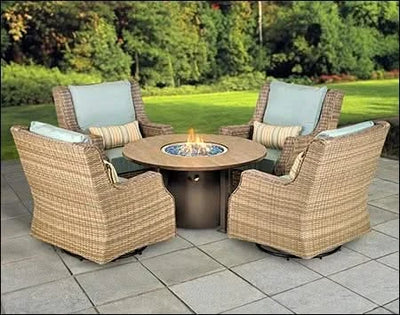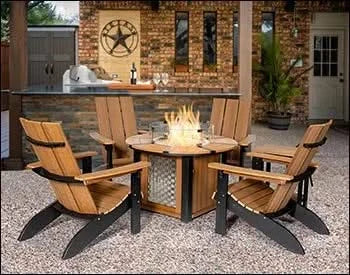A common safety misconception often arises when people consider adding a covered element over their outdoor fire pit. To be clear, you should never place a temporary canopy directly over a fire pit. This creates a severe fire hazard, as the intense heat and embers can quickly ignite flammable materials like fabric or plastic.
Our clients, however, had a specific vision: they wanted to place a fire pit under a more permanent outdoor structure to create a cozy, covered outdoor space. This led to the question: Is it safe to have a fire pit under a gazebo? The answer is yes, it can be, but there are crucial safety considerations to keep in mind
In this blog post, we'll explore the safety considerations involved in placing a fire pit beneath a gazebo, pergola or any garden structure for that matter. We'll delve into local regulations, ventilation needs, and general fire safety tips to help you decide if this is the right choice for your outdoor living space.
Table of Contents
- Safety Considerations for Gazebos and Fire Pit
- Fire Pit Factors to Consider
- Types of Fire Pits
- Fire Feature Compatibility with Gazebos
- What is the Best Fire Pit for a Gazebo?
- Our Top Recommended Fire Pits Safe for Gazebo Use (Gas and Propane)
- Preparing Your Gazebo
- Alternative Heating Options for Your Gazebo
- Enjoy Your Gazebo All Year Round
- Using a Fire Pit Under a Gazebo FAQs
Safety Considerations for Gazebos and Fire Pit
Using a fire pit under a gazebo can be a great way to enjoy your outdoor space, but it's important to prioritize safety. While many people safely use fire pits in gazebos, there are specific guidelines to follow. It's feasible to place a gazebo over a fire pit, but it's essential to consider the safety aspects before doing so.
Local Regulations
Before proceeding with any project involving a fire pit under a gazebo, it's crucial to consult your local regulations. These regulations often outline specific guidelines for fire pit placement, size, fuel type, distance from structures, and any restrictions on the type of fuel or size of the fire pit.
By understanding these regulations, you can ensure that your project complies with local laws and avoid potential fines or penalties. Additionally, following these guidelines will help to minimize the risk of fires and property damage.
Ventilation Needs
One of the biggest concerns when using a fire pit under a gazebo is ventilation. To ensure safety and prevent smoke buildup, proper airflow is crucial. Here are some tips:
- Choose a gazebo with open sides or a retractable roof. This allows for fresh air circulation and minimizes smoke accumulation.
Our in house outdoor living experts recommend the following Amish outdoor wooden structures by YardCraft:
12x18 YardCraft Gazebo
 Propane Fire Pit under a Gazebo
Propane Fire Pit under a Gazebo Key Features of YardCraft Gazebo & Benefits for Fire Pit Use:
Open Sides:
- The most prominent feature is the open-sided design. This is crucial for ventilation, allowing smoke and heat to disperse easily. This greatly reduces the risk of smoke buildup and potential fire hazards compared to fully enclosed structures.
High Ceiling/Roof:
- A higher ceiling allows for better vertical ventilation, helping to carry smoke and heat away from the fire pit. This is important for preventing heat damage to the roof and ensuring a comfortable environment.
Wooden Construction (with caveats):
- While wood is combustible, YardCraft's Amish-built structures are well-constructed and sturdy. The wood has been treated for weather resistance, and has some degree of fire retardancy.
Spacious Size (12x18 Octagon):
- The 12x18 size provides ample space for a fire pit and seating, allowing for safe distances between the fire and the gazebo's structure. This reduces the risk of accidental contact with flames or hot surfaces.
- The Octagon shape also provides a good even distribution of space around the fire pit.
Concrete Base:
- A concrete base is highly recommended for fire pit safety, providing a non-combustible surface. While not included, YardCraft offers a convenient floor kit that can be purchased separately, ensuring a stable and safe foundation for your gazebo and fire pit.
Shop 12x18 YardCraft Gazebo Now
12x12 YardCraft A Frame Pavilion

A clean burning fire pit, can be used safely under this YardCraft A-frame pavilion, because the A frame design allows for proper ventilation, for a comfortable warm outdoor space.
This pavilion is a great value, it is a perfect size for smaller backyards, and is more affordable than other pavilions.
General Fire Safety
Of course, fire safety is always a top priority. Make sure you have a fire extinguisher readily available and that everyone in your household knows how to use it. It's also a good idea to keep a bucket of water nearby in case of a small fire.
In a nutshell, while it is possible to have a fire feature under a gazebo, it's important to take safety precautions. By following local regulations, ensuring proper ventilation, and practicing general fire safety, you can create a beautiful and enjoyable outdoor space.
Fire Pit Factors to Consider
When choosing a fire pit table for your gazebo, there are several factors to consider:
Size
Ensure the fire pit bowl fits comfortably within the space of your gazebo.
Style
Select a fire pit table that complements the design and architecture of your outdoor structure.
Safety Features
Opt for one with safety features like a protective screen, spark guard, or cover.
Fuel Type
Decide on the type of fuel suitable for your needs (wood, propane, natural gas, or gel fuel).
Materials
Evaluate the materials used in the fire pits construction for durability and weather resistance.
Types of Fire Pits
There are various types of fire pits available, each with its own benefits:
Wood-Burning Fire Pits
These classic fire pits use wood as fuel, providing a traditional ambiance with crackling flames and aromatic smoke. However, whether they are a good choice to pair with an outdoor structure is questionable. We will be covering this in the upcoming section of this article.
Gas Fire Pits
Growing in popularity, natural gas fire pits offer the convenience of clean-burning fuel and easy ignition.
Bioethanol Fire Pits
These environmentally friendly options produce a clean and smokeless flame, ideal for indoor and outdoor use.
Propane Fire Pits
Portable and versatile, propane fire pits provide a convenient and efficient heat source.
Fire Feature Compatibility with Gazebos
When considering fire pit compatibility with gazebos, safety should be the top priority. Here's a breakdown of how different fire pit table types align with gazebo usage:
- Wood-Burning Fire Pits: While they offer a traditional ambiance, wood-burning fire pits produce the most smoke and sparks. It is not recommended to use this type of fire pit under a gazebo. Especially as there are other better and safter options that you can choose from.
- Gas Fire Pits: Gas fire pits are generally safer for gazebo use due to their cleaner burning and reduced smoke production. However, ensure proper ventilation and follow local regulations regarding gas line installation.
- Bioethanol Fire Pits: These smokeless options are ideal for indoor and outdoor use, including under gazebos. However, ensure proper ventilation and avoid placing them too close to flammable materials.
- Propane Fire Pits: Portable propane fire pits can be a convenient choice for gazebos. Ensure they are placed on a stable surface and away from flammable materials.
Remember, always consult local regulations and consider the specific design and materials of your gazebo when choosing a fire pit. By selecting a fire feature that is both safe and compatible with your gazebo, you can create a cozy and enjoyable outdoor space.
What is the Best Fire Pit for a Gazebo?
Choosing the ideal fire feature for your gazebo is a matter of balancing safety, aesthetics, and personal preference. While each type of fire pit offers unique advantages, gas fire pits often emerge as the preferred choice due to their safety and convenience.
Gas fire pits are generally considered safer for gazebo use due to their cleaner burning and reduced smoke production. They provide a consistent flame without the hassle of wood-burning fires. Additionally, gas fire pits are often equipped with safety features like automatic ignition and adjustable flames, enhancing overall safety.
However, wood-burning fire pits can still be used under gazebos with proper precautions. Ensure your gazebo is well-ventilated, made of fire-resistant materials, and positioned at a safe distance from the fire pit. Consider wood-burning fire pits with features like spark screens and enclosed designs to minimize fire hazards.
Ultimately, the best fire pit for your gazebo depends on your specific needs and preferences. Consider factors such as your desired ambiance, level of maintenance, and local regulations.
Our Top Recommended Fire Pits Safe for Gazebo Use (Gas and Propane)
Elementi Plus Sofia Marble Porcelain Fire Table
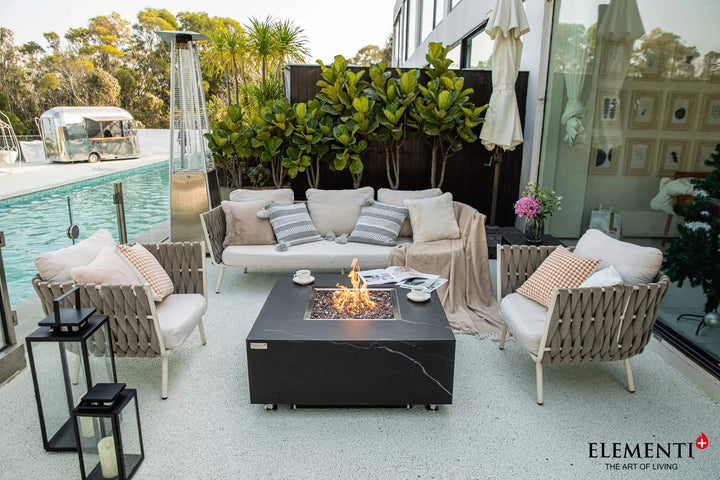
$3,979.00
Turn your patio into a captivating retreat with the Elementi Sofia Black Marble Porcelain Fire Table. This meticulously crafted outdoor fire table seamlessly blends modern design with functionality. It the perfect centerpiece for a smaller outdoor space. Sofia Marble Porcelain… read more
Fifthroom Oasis Poly Round Fire Pit Table with Chairs
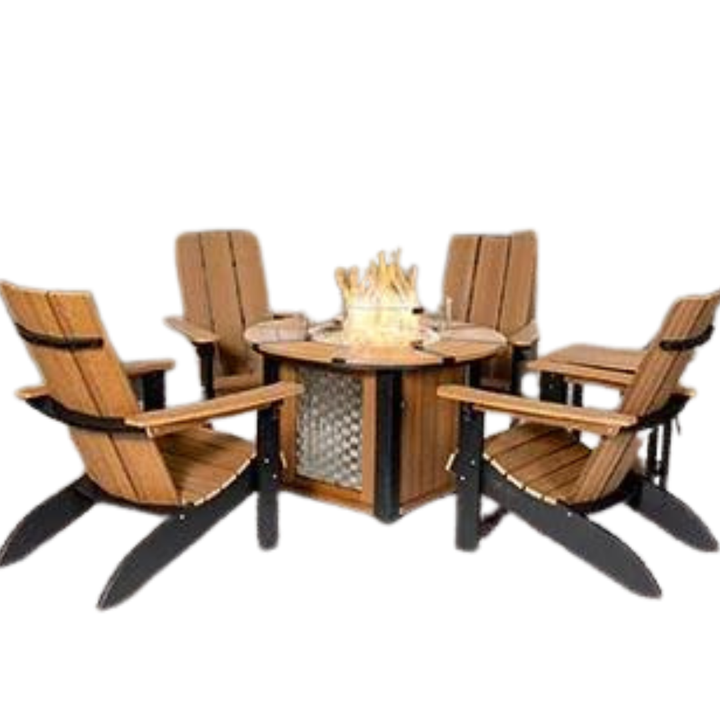
$5,395.00
Elevate your outdoor living with Fifthroom's Oasis Poly Round Fire Pit Table with Chairs. This stylish and functional piece combines the warmth and ambiance of a fire pit with the comfort of a table and matching chairs. It truly makes… read more
HPC Fire Tempe Hammered Copper Gas Fire Bowl
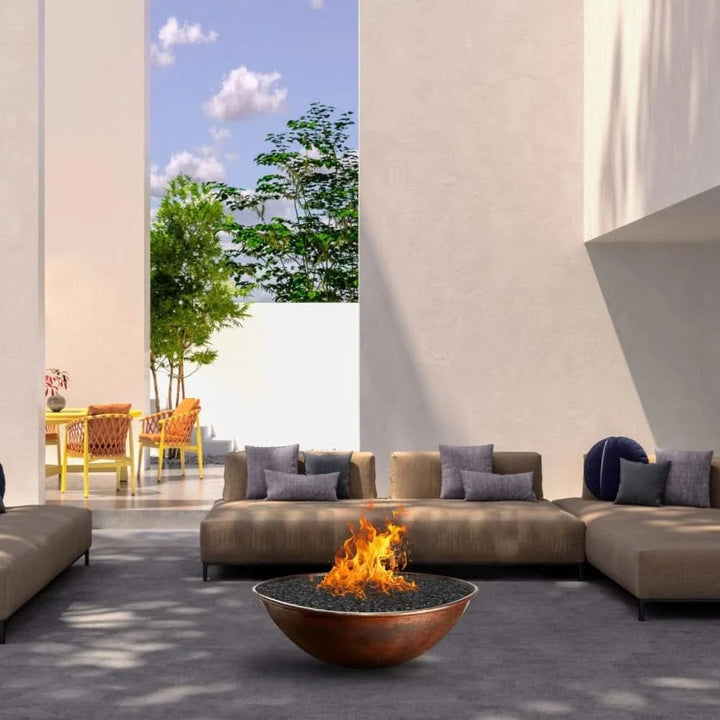
$4,495.79
HPC Fire's Tempe Hammered Copper Gas Fire Bowl will bring timeless beauty to your outdoor living space. This handcrafted fire pit features a stunning oiled copper bowl, hand-hammered for a unique and luxurious look. It will be the centerpiece of… read more
Preparing Your Gazebo
When adding a fire pit table to your gazebo, proper preparation is key to ensuring a safe and enjoyable experience. Here are some essential steps to consider:
1. Check Local Regulations:
Before proceeding, verify any local regulations, codes, or permits related to fire pits usage under structures like gazebos. This will ensure compliance with specific guidelines in your area and avoid potential issues.
2. Ensure Adequate Clearance:
To prevent accidental fires and ensure proper airflow, maintain these minimum clearances:
- Horizontal clearance: 36 inches (91.4 cm) between the edge of the fire pit and any combustible materials like wood, fabric, or plants.
- Vertical clearance: 8 feet (243.8 cm) between the top of the fire pit and the lowest part of the gazebo's roof.
Note: These are general guidelines. Always consult local regulations for specific requirements in your area.
3. Prioritize Ventilation:
Proper ventilation is crucial for preventing smoke buildup and ensuring a safe environment. Consider factors like the size of your gazebo, the type of fire pit table you're using, and the prevailing wind direction.
4. Protect Your Gazebo:
Lay down a fire-resistant base or mat underneath the fire pit table to protect the gazebo floor and minimize the transfer of heat to the structure. This will help safeguard your investment and enhance safety.
How High Should a Roof Be Over a Fire Pit?
The height of your gazebo's roof is a crucial factor when using a fire feature beneath it. A minimum clearance of 8 feet (96 inches) between the top of your fire pit and the lowest part of the overhead cover is generally recommended. This allows for adequate ventilation and prevents heat and smoke from damaging the roof or causing hazards.
Fire Table Placement
Proper placement of your fire pit within the gazebo is essential for safety and enjoyment. Here are some guidelines:
- Center the fire pit: This ensures even heat distribution and prevents the fire from getting too close to the gazebo's walls.
- Maintain a safe distance: Keep a safe distance between the fire pit and any flammable materials, such as curtains, furniture, or plants.
- Consider airflow: Place the fire pit in an area where there's good airflow to prevent smoke buildup and ensure proper ventilation.
Alternative Heating Options for Your Gazebo
While fire pits offer a classic outdoor experience, there are other heating options that can create a cozy atmosphere in your gazebo without the same safety concerns.
1. Patio Heaters: Gas or electric patio heaters can provide a steady source of warmth without the open flame of a fire pit. They are available in various styles and sizes to suit your needs.
2. Fire Bowls: Fire bowls offer a similar aesthetic to fire pits but with a smaller, enclosed design. They often produce less smoke and are easier to clean.
3. Electric Heaters: Portable electric heaters can be a convenient option for smaller gazebos. They are easy to use and can be moved around as needed.
4. Outdoor Fireplace: If you have the space, an outdoor fireplace can create a focal point in your gazebo and provide plenty of warmth.
Enjoy Your Gazebo All Year Round
By carefully considering your options and prioritizing safety, you can create a cozy and enjoyable outdoor space in your gazebo. Whether you choose a traditional fire table, a modern patio heater, or another alternative, the key is to select a heating option that complements your gazebo's design and meets your specific needs.
Remember to always follow local regulations, ensure proper ventilation, and prioritize safety when using any heating device in your gazebo. With the right choices, you can transform your gazebo into a year-round retreat where you can relax, entertain, and enjoy the beauty of nature.
Using a Fire Pit Under a Gazebo FAQs
Can you put a fire pit under a metal gazebo?
It's important to approach the idea of placing a fire pit under a metal gazebo with a strong emphasis on safety. While it's not inherently impossible, several critical factors must be carefully considered.
First and foremost, adequate ventilation is absolutely essential. The risk of carbon monoxide buildup in enclosed or semi-enclosed spaces is a serious concern. Therefore, ensuring ample airflow to disperse smoke and fumes is paramount.
The material of the gazebo itself is also a significant consideration. Although metal gazebos are less flammable than those constructed from wood or fabric, they can still be susceptible to damage from excessive heat. The gazebo's finish and the thickness of the metal are crucial factors, as thin metal can warp or buckle under high temperatures.
The type of fire pit used also plays a role. Gas or propane fire pits are generally considered safer in this scenario, as they produce less smoke and sparks. Wood-burning fire pits, on the other hand, carry a higher risk of sparks igniting nearby materials.
Maintaining a safe clearance between the fire pit and the gazebo's structure is also vital. This includes ensuring sufficient vertical clearance to prevent heat damage to the roof and keeping the fire pit away from the gazebo's support posts.
Finally, it's essential to check local fire codes and regulations regarding fire pit use under structures, as some areas may have specific restrictions or prohibitions.
In essence, if you choose to proceed with placing a fire pit under a metal gazebo, prioritize safety above all else. Opting for a gas fire pit, ensuring excellent ventilation, maintaining ample clearance, and always having a fire extinguisher readily available are crucial steps.
Can you have a gas fire pit under a gazebo?
Yes, you can have a gas fire pit under a gazebo, but it's crucial to prioritize safety. Gas fire pits are generally safer than wood-burning ones due to reduced smoke and sparks. However, even with a gas fire pit, ensure excellent ventilation to prevent carbon monoxide buildup. The gazebo's material is also a factor, with metal being preferable to flammable materials. Maintain ample clearance between the fire pit and the gazebo's structure, and always check local fire regulations.
Can I put a propane fire pit under a gazebo?
Using a propane fire pit under a gazebo is feasible, but it's vital to prioritize safety. Propane fire pits are generally safer than wood-burning options, yet they still generate heat and potentially fumes. Adequate ventilation is absolutely necessary to prevent carbon monoxide buildup.
Ensure sufficient clearance between the fire pit and the gazebo's roof and sides. The gazebo's material is important; metal is preferred over flammable materials. Always consult local fire codes and regulations. Keep a fire extinguisher readily available. Essentially, while propane fire pits can be enjoyed under gazebos, prioritizing ventilation, spacing, and adherence to safety guidelines is crucial.

